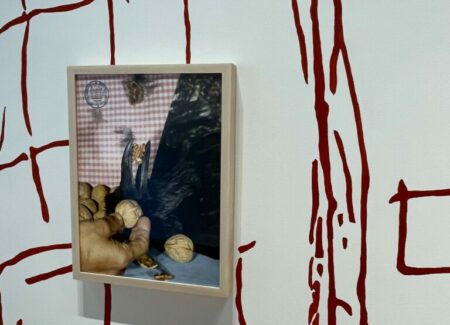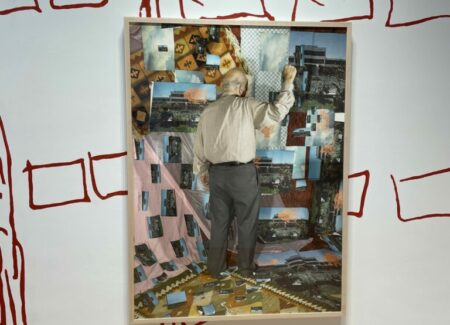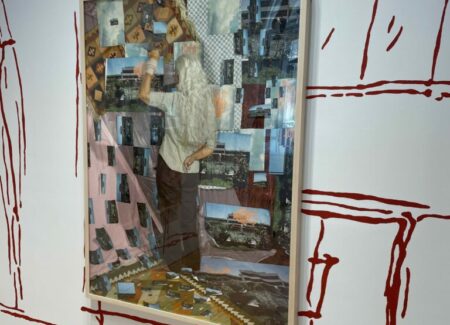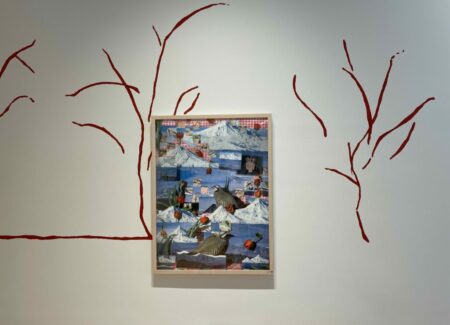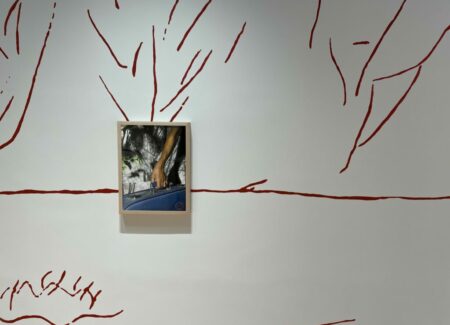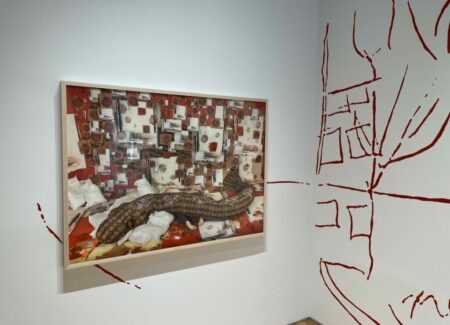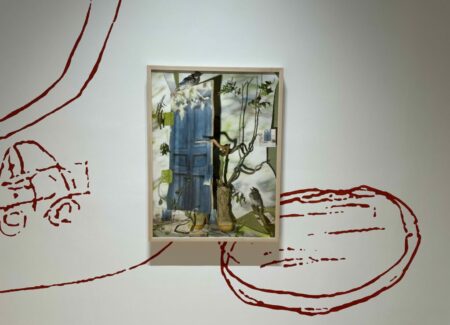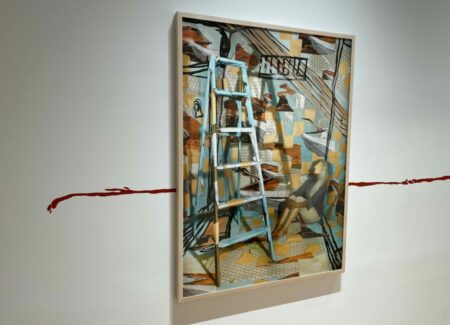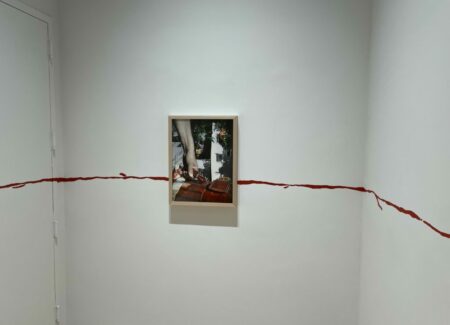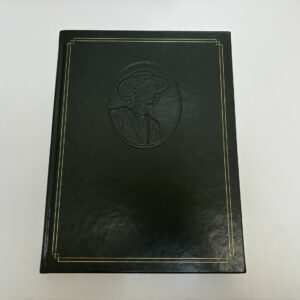JTF (just the facts): A total of 9 color photographs, framed in light wood and unmatted, and hung against white walls with red painted illustrations in the multi-room gallery space. (Installation shots below.)
The following works are included in the show:
- 4 archival pigment prints, 2023, sized 60×44 inches (or the reverse), in editions of 3+2AP
- 2 archival pigment prints, 2023, sized 40×30 inches, in editions of 3+2AP
- 3 archival pigment prints, 2023, sized 24×18 inches, in editions of 5+2AP
Works from this project are also currently on view at the MFA Boston (here).
Comments/Context: For many contemporary Iranian-American artists, their family histories are meaningfully marked in one way or another by the events of the Islamic Revolution in Iran in the late 1970s. Some families stayed on after the fall of the Shah and became active political dissidents; others fled and became refugees, building new lives in the United States and elsewhere. Regardless of the choices made and the eventual circumstances encountered, memories of those traumatic days, especially in the lives of parents and elders, remain strong. And now with fresh waves of political and cultural protests churning through Iran (particularly in the form of the the ongoing Woman, Life, Freedom movement), many of these histories and remembrances are being revisited, becoming raw material for a new round of artistic expression.
Iran’s recent political realities, and the ways those events have been captured by Western media, have provided consistent inspiration for Sheida Soleimani’s staged photographs. In her 2020 gallery show (reviewed here), various political figures (both from Iran and elsewhere), the sprawling global oil industry, the recent sanctions on Iran, and the negotiations around the Iran nuclear deal were all incisively deconstructed and satirized within the confines of her collaged assemblages and installations. But in her new works, Soleimani bridges out of that broader political environment and turns back to the contours of her own family history. Like a ghostwriter, she collaboratively retells the stories of her parents from the position of being one step removed, adding her own layers of interpretation and reimagined narrative.
Soleimani’s images have often used repetitions of collaged imagery and overlapped pattern as compositional elements or backdrops, and several of her new works feature variations on a checkerboard as a visual theme, reminiscent of the board in the children’s game “Snakes and Ladders”. Images (of buildings, long roads, and screened wire fencing) are placed against draped fabrics in repeating arrangements, and are then intermingled with the blocked geometries of carpets, creating densely immersive, almost pixelized environments. Her aging parents are alternately posed in one setup (in works titled “Agitator” and “Dissident”), with faces turned away and fists raised, still standing defiantly. Soleimani has then further embraced the motifs of the ancient game (the ladders that take players upward, and the snakes that lead them down) and applied them to other moments from her parents’ life story. In “Panjereh”, one of the strongest works in the show, her mother sits on the floor (with her face obscured) flanked by a large ladder, with other painted ladders mixed into the surrounding walls, perhaps alluding to available ways out or journeys made; a playfully huge snake makes an appearance in “Rice Cellar”, the symbolic recreation of a specific scene from her father’s life, when he escaped from Iranian government officers sent to arrest him by hiding under bags of rice in the basement.
Other images in the series pull in closer to resonant symbols. Two works, “Safar” and Taghato”, use luggage as the primary subject (one piece with a dated JFK bag tag), the suitcases alluding to her parent’s roles as refugees and immigrants; these two images (with respective male and female hands) are backed by arrays of pictures of shadowed buildings and thickets of plant life, the darkness of those scenes interrupted by small snippets of green growth (and a couple of pomegranates). Another notable work, “Behind the Door”, uses layers of doors and hinges as the memory trigger, with a pair of combat boots (a clear identifier of an Iranian government official) surrounded by both snakes and birds, with the corresponding negative and positive allusions (of death and potential freedom) in shifting conflict.
What’s intriguing about this body of work is that it finds Soleimani reprocessing her own history using the visual strategies and approaches she previously applied to images of global politics. In retelling autobiographical stories, and visualizing family lore fabricated from handed down memories, Soleimani has turned those very real events of survival, resilience, and activism into something like personal parables. While the acerbic bite of her visual wit has been muted in these new images, what replaces it is something more sensitive and attentive. Soleimani is clearly quietly proud of the adventurous, risk-taking lives her parents have led, and has infused her resulting images with her own brand of empathetic defiance.
Collector’s POV: The works in this show are priced at $5500, $10500, and $14000, based on size. Soleimani’s work has little secondary market history at this point, so gallery retail likely remains the best option for those collectors interested in following up.
